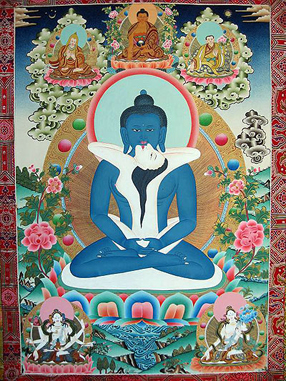What Is Tantra
From Bluetruth
A Definition of Tantra by Suzie Heumann
Definition of Tantra In our rush to categorize and assign meaning to our experiences, we often elevate the spiritual above the events of our normal lives. Yet what we find most moving is spiritual. When we are deeply affected, able to let go and banish our always-assessing egos, we are having a spiritual experience.
Many people able to reach deep ecstatic sexual states liken these to transcendental spiritual experiences. They discover that the distinction between the physical and the spiritual is not as clear as they were taught. They may even feel that they have come to know God, or ultimate reality, through sex. Tantra Yoga and the Kama Sutra both view sexuality as vital aspects of the path to enlightenment.
The approximate Sanskrit definition of "Tantra" is "web" or a union of opposites that, when united, becomes one with everything in the universe. Tantric practice unifies the many contradictory aspects of the self (e.g., masculine and feminine, spirit and matter, dark and light) into a harmonious whole.
Developed in India, Tantric practices were at their height between 500 to 1300 AD. Today Tantra is a living system designed to promote rapid growth towards enlightenment. Tantra's components include yoga, meditation, deity worship, whole-body health, and Ayurvedic medicine.
There has been a renewal of interest in Tantric practice in the West. Many couples are looking to improve their sex life. Perhaps because our society is maturing or because of a widespread awakening of consciousness, we seem to be gravitating towards the lessons in conscious intimacy that Tantra has to offer. Most of us know very little about our own bodies and our potential for pleasure.
Though most of us won't seek out a guru to guide us in our Tantric practice, learning even the simplest of the techniques can bring a sense of greater communion with our partners, our natures, and, ultimately, with our souls. One's love life may dramatically improve when tantric practices are learned. Our spirits open when we engage in more trusting sexual relationships that involve communication, the spirit of playfulness, and being open to discovery.
Meditation, Yoga and Tantra
Like meditation and yoga, Tantric sex is a spiritual practice. It is not aimed at self-indulgence or pleasure as an end in itself. Tantra uses sexuality, with all of its rawness, social stigma, fear, and vulnerability to crack open our egos so that we can be present with our lovers, and ultimately, with ourselves.
The modern seeker may find that many of the components of ancient Tantric practices integrate well with our daily lives. In fact, the experiences one has practicing Tantra can give one tools for being more present and aware in all aspects of one's life.
Tantra is sometimes called the sexual yoga, though this concept can be misinterpreted. Yoga is another term associated with practices that help to unify apparent opposites. When doing yoga, you are actually performing an active meditation, focusing your energy on internal, as well as external, points. You bring much more awareness to the body and mind with yoga. In Tantric sexual practices the same is true.
The beauty of Tantra is that it is a partnered path of learning. Trusting another with your personal growth is the ultimate act of surrender--and surrendering is where breakthroughs can happen. Two people taking conscious risks that gently stretch the limits of their comfort zones can realize great growth—individually and as partners.
One must be willing to risk "doing it wrong," not looking good, being stuck emotionally, facing one's own shadows, and other life challenges. If you discover, for example, that you fear intimacy, Tantra can help you move toward the fear with courage and trust.
How you face your sexual fears is a great metaphor for how you deal with fear in general. In sex, you cannot hide from the truth--the feedback is immediate. If your body feels pleasure, it feels pleasure. If it feels numb, it feels numb, and you know it. Once acknowledged, many of our fears lose their ability to hold us back from the wholeness in life that we deserve.
The Male and Female Essence
"Being well practiced at the art of sexual ecstasy and having entered the divine realms of ego dissolution over and over allows for the veils and boundaries of separation to fall at our feet. We open again and again, each time allowing more in - friends, lovers, family, nature, abundance, light, dark, spirit. Nothing seems separate anymore, including our own selves. At times we can even experience our own divinity - our own true nature. This is when transformation and transcendence occurs." - Suzie
Tantra originated in Hindu India. Though it is not a religion in itself, it is based on the Gods and Goddesses of the Hindu pantheon. The Gods and Goddesses represent the male/female, yin/yang qualities of all humans. Healthy individuals are a unique blend of female and male traits.
Shiva is the supreme God in Tantric beliefs. He represents the male principle and the control and movement of time and all material things. His penis, or Lingam in Sanskrit, is upright, action-oriented, and powerful, commanding a "nerve center" of worldly power.
Shiva's counterpart is Shakti - the female essence. Shakti’s energy runs the universe. Without Shakti, Shiva would have no power. She is the creator, the sustainer, and the destroyer all in one. Consider that a woman gives birth, sustains the child with milk (the equivalent of Mother Earth feeding her children), and takes back her child in death, as does Mother Earth.
These two deities form a union that keeps the universe in perfect harmony, and their story is a metaphor for each of us. According to Tantric philosophy, life is a journey to become a balanced blend of both of male and female, that is, to become whole or unified. With practice, your sexual nature can lead you to this perfect balance.
Subtle Energy
In Eastern medicine, the chakras are seven "energy centers" situated along the spine in what is called the subtle body. Practitioners of Eastern medicine treat the subtle body as well as the gross physical body; the health of the chakras is essential to the overall health of the individual. Each of the chakras is associated with one of the basic core energies that we work with in life. The energy that flows through them up the spine is called Kundalini Energy.
As you extend your practices of Tantra and other sciences relating to the body, you begin to see where you flow easily and where you get stuck in life. As you sense the energies in your chakras through Tantric practice, you can discover where you need to put your attention in order to revitalize yourself.
The First Chakra - Muladhara
The first chakra resides in the pelvis area. It represents being grounded and secure in the physical necessities of life: food, shelter, and the needs of our animal nature. Its element is Earth and its color is red. A secure first chakra enables us to feel confident in our abilities to care for ourselves. We have a realistic concept of our needs and a sense of being grounded.
The Second Chakra - Svadhishthana
The genital area is the seat of the second chakra. It represents our sexual urges and fantasies, creativity, and procreation. Its element is water, its color orange. Sensation, pleasure, sexuality, and emotions are associated with this chakra. When it is "open" and healthy, we are likely to experience stable emotions, gracefulness, and self-acceptance.
The Third Chakra - Manapura
This chakra is situated at the solar plexus or navel area. It represents our power, will, energy, authority, and longevity. Its element is fire and its color yellow, as the sun is yellow. Ego identity and self-esteem are the products of a healthy third chakra. Confidence and autonomy without the need to dominate or manipulate kindle the fire necessary to live a powerful and compassionate life.
The Fourth Chakra - Anahata
The chest area and specifically the heart are the home of the fourth chakra. It represents all that is associated with heart: sharing, love, service, compassion, and devotion. Its element is air, its color green. We can all recognize the times when our heart feels shut down, often when we are mad, hurt, pitying ourselves, or when we don’t feel loved. We feel it as a stuck or tight area in the chest. Jealousy has been called the Green-Eyed Monster in honor of the heart chakra and its color.
The Fifth Chakra - Vishuddha
This is the throat area, which represents knowledge and speaking the truth of that knowledge. Its element is ether or space, and its color is violet. The throat chakra builds upon knowledge taking what we have learned and helping us to speak what we know. When was the last time you had a "lump" in your throat? That is your fifth chakra telling you that you don’t know all of the facts, that you are afraid to speak up, or that you aren’t in integrity with what you are saying. Stop, breathe deeply, notice what you are avoiding, and tell the truth.
The Sixth Chakra - Ajna
Located at the pineal gland or "third eye" of the forehead, the sixth chakra symbolizes enlightenment and self-realization. It has no element as it is beyond the elements. Its color is bluish white. Self-mastery, intuition, and insight are signs of an open sixth chakra. We can get past old, recurring patterns in our lives when our sixth chakra is healthy. Often this chakra opens up through a "spiritual" emergence or awakening.
The Seventh Chakra - Sahasrara
This chakra is located at the fontanel, the soft spot on a baby’s head. It is the open conduit to God and the guru within. Golden white light and a lotus flower with a thousand petals are the symbols of this chakra. A supremely conscious person exhibits compassion, self-awareness, mindfulness, and awareness of the world; that person would have a very evolved seventh chakra.
Balancing Body, Mind, and Spirit
"Correct practice of sexual intercourse can cure every ailment and at the same time open the doors to liberation." --Taoist Master, from Passion Play, by Felice Dunas.
Tantra offers many easy-to-learn practices to help you and your partner evolve spiritually while enjoying great sex. Many of the lessons come from Tantric theory and have been refined by modern psychology. Focus your mind on your heart and your partner’s heart when you are making love.
Connecting the Heart and the Physical Orgasm
Here is a simple practice you can try the next time you are making love. Both men and women need to learn to connect the genitals and the heart. Touching these two areas at the same time can help a person experience this connection, which carries the potential for immense healing.
During foreplay or oral sex and while you are stimulating the genitals of your partner, place your hand on his or her heart. Think about experiencing a pure heart orgasm or extending the orgasmic release from the genitals up to the heart. You may want to wave your hand over your partner's body with a special focus on the heart. Remind your partner that orgasm can spread up to the heart.
Meditation
Meditation brings focus and quiet to the mind. As little as 20 minutes a day can bring relaxation, concentration, and lower blood pressure to most people.
Practicing meditation will teach you how to focus your attention when you're making love. Most people at some time or another during sex have found their minds wandering or worrying about whether they are doing it right or about what they wish their partners would do. The highest honor you can give your partner is truly focused attention. When you bring that quality to your loving, it doesn’t matter what techniques you know – you simply are a great lover.
"Slow down, enjoy love’s dance. Make your sexual loving a meditation, and use the moment of orgasm to affirm and empower one another." --Charles and Caroline Muir, Tantra, the Art of Conscious Loving
Tantric Orgasm
Tantric philosophy talks about two seemingly different types of orgasm, the physical orgasm and the heart orgasm. At first appearance they may seem contrary to one another, but on closer inspection one complements the other.
Tantric practice encourages us to be in our hearts 24 hours a day. That blissful state can be equated to an orgasmic state of being with "heart energy" transferred to all that we do. In Tantra this is sometimes referred to as the "right hand path," and some practitioners achieve this state of being through meditation, yoga, compassionate states of mind, mantra chanting, and celibacy.
In the "left hand path," sexuality is the vehicle one rides to achieve the same state of bliss. Developing a consciousness with orgasm provides a gateway to an ability to attain higher states of consciousness. As in the "right hand path," the bliss state can then be brought to all aspects of life. You really can "get high with a little help from your friends."
Full Body Orgasms
Sexologists have identified several forms of orgasm. In women there is the clitoral orgasm, which tends to be localized to the genitals. The vaginal orgasm involves the G-spot and other areas of the vagina. A blended orgasm involves the clitoris and the G-spot. Men’s orgasms tend to be more general, though through Tantric practices the plateau can be extended for long periods of time. Tantra adds another kind of orgasm, the energy orgasm or heart orgasm.
As you go further into this practice you are able to begin to have full body orgasms, or energy orgasms, simply by breathing them, without any physical touch. This powerful energy is then much more available to you in your everyday life, sometimes just by breathing!
When the paths are blended, the possibilities for personal growth expand exponentially, and the duality between the types of orgasms vanishes. Just as breath is of the utmost importance in meditation, it is the consciousness of breathing that can be the tool to a transformational lovemaking experience.





